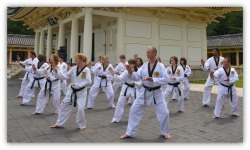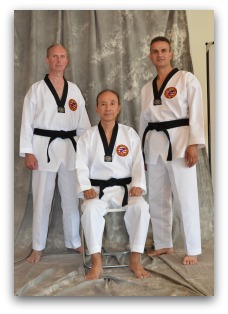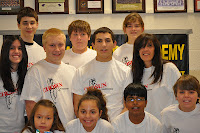TaeKwonDo Times Magazine November, 2012
"Traditions" column
(appears in every edition)
Observing
a martial artist seated quietly in a meditative posture bears little
resemblance to the skilled defender most assume him to be. Meditation, however,
plays a vital role in preparing the taekwondoist, both mentally and
spiritually, for the demands of self-defense, the benefits of ki development, and a potential leap in
performance through the practice of visualization.
In
order to act rapidly in the face of a threat that has escalated beyond verbal
mediation, the mind and the body must react
rather than anticipate; this
important principle lies at the core of traditional defensive strategy. Making
the false assumption that an attacker will execute a punch when, in truth, his
intention is to kick, is certain to result in severe injury to the defender. To
appreciate the value of meditation as it applies to this component of
self-defense, one needs look no further than the stillness of a serene pool of
water reflecting the image of a full moon. Because the surface is unbroken by
ripples, the image is pure and undistorted.
The mind of the martial artist can be conditioned to act in a similar
fashion. Through the sincere and diligent practice of meditation, the
taekwondoist will develop an uncanny ability to react to an unprovoked attack
rather than anticipate a potential false move. How is this possible? The
mind, like an unbroken stallion, has a proclivity for galloping away when left
to its own designs. Thoughts of daily activities, bills, work or school, all
have the ability to intrude on a tranquil mind. Great effort is required to
focus on stillness, emptiness. Nothing, no mind, or mushin, is what the martial artist seeks. Mushin is the mental
state where one is unhindered by preconception. Yet, as difficult as this stage
of consciousness may be to achieve, we do have an ally in our quest. Just as
the Asian warriors of the past, who walked a razor’s edge between life and
death in the service of their king, meditated before battle, we too, as modern
day warriors can relieve the dangers of anticipation by cultivating a clear and
tranquil mind. However, there are many types of meditation. Which is
appropriate to achieve the result we desire? One approach my students and I
practice at the Chosun Taekwondo Academy as a preface to our training consists
of sitting cross-legged in the half-lotus posture on a folded blanket to
promote comfort. The hands are positioned in a gesture known as a mudra, a Sanskrit term meaning to seal
or authenticate. Again, there are a
variety of mudras, each intended to amplify or authenticate a spiritual
concept. The cosmic mudra, where the
back of the right hand is placed in the palm of the left hand (reverse for
men), thumbs touching, is a simple and effective mudra to begin with. Make a
perfect oval rather than permitting the thumbs to create a “peak” or the palms
to collapse into a “valley”. Let the hands gently rest in the lap, close the
eyes and sit erect with the nose in line with the navel. Aside from allowing
for a smooth exchange of breath, this posture will encourage a free flow of ki, or internal energy, to circulate
throughout the body. Using the breath as a focal point, slowly inhale through
the nose and exhale through the. Invariably, as you meditate, stray thoughts
will attempt to invade the mind; briefly acknowledge these feelings and permit
them to pass through your consciousness, all the while returning to your
breathing. Assign a single count to each cycle of inhalation/exhalation. Count
to ten only and then return to one. Eventually, with patience and time, you may
be able to abandon your counting altogether and simply focus on the breath.
This basic method of meditation should serve to calm the mind prior to training
and partially eliminate the distraction of anticipating rather than reacting.
Moreover,
enhancing the flow of ki throughout the body is yet another objective of
meditation. Why is this abstract action important to the martial artist? The
manipulation of ki, the universal life force, can be used for both benign and
punitive purposes. For instance, in order to promote health, the practitioner
of kiatsu, or ki therapy, messages
the various acupoints along the body
to stimulate ki flow; when an abundant amount of ki is present, a sense of well
being is experienced, when it is deficient, illness results. The taekwondoist,
on the other hand, channels ki to a specific part of the body with the hope of
amplifying technique and to prevent injury. This requires long practice but can
be addressed through meditation and breathing exercises. While inhaling and
exhaling, place your hands on your abdomen. What do you feel? When you breathe
in, the abdominal area should expand; likewise, when you exhale, the abdominal
area contracts. This process is commonly known as normal or Buddhist Breathing. Now, make a
conscious effort to reverse this sequence, allowing the opposite to occur where
the area surrounding your tan-jun, or
ki center, two inches below the navel, contracts during inhalation and
conversely expands when you exhale. This style of breathing is referred to as
reverse or Taoist Breathing and
represents an ancient method by which your breathing acts as a pump to move the
flow of ki throughout a series of pathways or meridians traversing the body. This practice coincides with the
last mission of meditation which entails visualization. Sitting in the
meditative posture described above, and employing the Taoist Breathing method,
visualize taking in a fresh, clean stream of ki through the nose as you inhale
and releasing a cloud of dark, used ki similar to smoke, as you exhale.
Following this meditation exercise, the body should feel revitalized and ready
for vigorous practice. At some point you can imagine lifting the ki from the
tan-jun and mentally transporting it to various parts of the body. As a
cautionary note, Taoist Breathing can have ill effects if used excessively and
should only be practiced for short periods of time.
Lastly,
visualization during meditation can also be used prior to promotion tests and
competitions as a precursor to success. It is not uncommon for the Olympic
competitor to mentally “see” him or herself performing flawlessly while meditating
before the actual event. Similarly, the martial artist can step through the
requirements of a belt test while in a meditative state and hopefully reduce
the stress intrinsic in the actual examination.
Clearly,
the practice of meditation presents great benefits for the taekwondoist and
should be a part of every style’s curriculum. Sadly, meditation is often overlooked
due to its metaphysical nature except in schools addressing the more
traditional aspects of tae kwon do. Nevertheless, the reward of adding a
meditative component to your training is obvious and should be explored with a
qualified instructor.
Master
Doug Cook,
a 6th dan black belt, is head instructor of the Chosun Taekwondo
Academy located in Warwick, New York, a senior student of Grandmaster Richard
Chun, and author of three best-selling books entitled: Taekwondo…Ancient Wisdom for the Modern Warrior, Traditional Taekwondo - Core Techniques,
History and Philosophy, and Taekwondo–A
Path to Excellence, all published by YMAA of Boston. Master Cook and
Grandmaster Chun have recently completed a new book focusing on Original Koryo
and Koryo poomsae targeted for publication in July of 2013. Master Cook can be
reached for lectures, workshops or questions at www.chosuntkd.com or info@chosuntkd.com.




.JPG)





 Kamsahamnida to all tour participants, family members, friends and fellow students at home who followed us online! It is not too early to consider making a dream come true in two years by reserving your place on the
Kamsahamnida to all tour participants, family members, friends and fellow students at home who followed us online! It is not too early to consider making a dream come true in two years by reserving your place on the 




